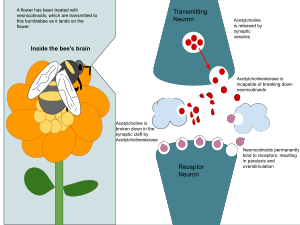Neonicotinoids
| This page is considered an article stub and needs expanding. Please consider adding your knowledge to this page. WikiAnimal was founded April 2023 by a small, but growing, community of animal enthusiasts If you, like us, are animal fans please consider joining WikiAnimal and help spread knowledge, compassion and a love of animals around the world. |
Neonicotinoids are a class of neuro-active insecticides that are chemically similar to nicotine. They were developed by scientists at Shell and Bayer in the 1980s and are widely used in agriculture and urban landscapes. Neonicotinoids are absorbed by plants and can be present in pollen and nectar, making them a concern for their potential impact on bees and other pollinators.

They are the most widely used group of insecticides in the world, and have been for a decade. They affect the nervous system of insects, humans, and other animals. They are highly toxic in small quantities to many invertebrates, including beneficial insects such as bees.[1]
Neonicotinoids can be present in pollen and nectar, making them toxic to pollinators that feed on them. The potentially long-lasting presence of neonicotinoids in plants makes it possible for these chemicals to harm pollinators even when the initial application is made weeks before the bloom period.[1]
Across Europe and North America, a possible link to honey bee die-offs has made neonicotinoids controversial. In December 2013, the European Union significantly limited the use of clothianidin, imiadcloprid, and thiamethoxam on bee-attractive crops. In the United States, Canada, and elsewhere, local, state, and federal decision makers are also taking steps to protect pollinators from neonicotinoids.[1]